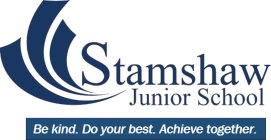Geography
Curriculum Statement
Geography at Stamshaw Junior School

Intent
At Stamshaw Junior School, we believe that Geography helps us understand the world we all live in. We want to teach children all about the earth’s physical and human processes so that they can understand how people, place and environment all interact and shape each other. We aim to foster in our children a sense of curiosity about the world around them so that they constantly ask questions such as “Why are those buildings there? Why does it flood? Can flooding be prevented? How are mountains formed?” We will help our children become geographers through using geographical specific language, developing an understanding of the earth’s key process and providing opportunities to actively experience geography through fieldwork and local trips. Our curriculum aims to ensure that children develop a sense of wonder about the world around us.
| The National Curriculum for Geography aims to ensure that all pupils: | |
|---|---|
|
Develop contextual knowledge of the location of globally significant places – both terrestrial and marine – including their defining physical and human characteristics and how these provide a geographical context for understanding the actions of processes |
|
|
Understand the processes that give rise to key physical and human geographical features of the world, how these are interdependent and how they bring about spatial variation and change over time. |
|
|
Are competent in the geographical skills needed to:
|
|
Implementation
We teach Geography in blocks linked to the topics we study. Children have the opportunity to learn about volcanoes and earthquakes, rivers and oceans, mountains and climate zones. To bring geography alive, we use reports from local and national news that relate to the topic we are teaching for example recent volcanic eruptions or earthquakes. We develop the children’s enquiry based skills through asking them questions such as “Where is a good place to build a castle?”
Children have plenty of opportunity to use atlases and maps to locate places and key physical features not only as part of geography topics but also science and history. We use the school grounds and local area to give children the opportunity to conduct fieldwork and develop the key skills of a geographer.
Cornerstones and other resources are used as the basis for our planning. In addition, we use a geography skills and progression document to ensure all areas of geography are taught and that children are able to deepen their understanding of the subject.
Impact
Formative assessments take place throughout the year and teachers evaluate the progress and attainment against the National Curriculum expectations of attainment.
Further information is gathered through pupil surveys to assess their understanding and enjoyment of geography.
The Geography subject lead monitors the impact and effectiveness the subject through looking at planning and the outcomes books. This ensures all learners in our school receive a high-quality Geography curriculum that meets the aims of this statement.
Geography Progression of Sequencing



